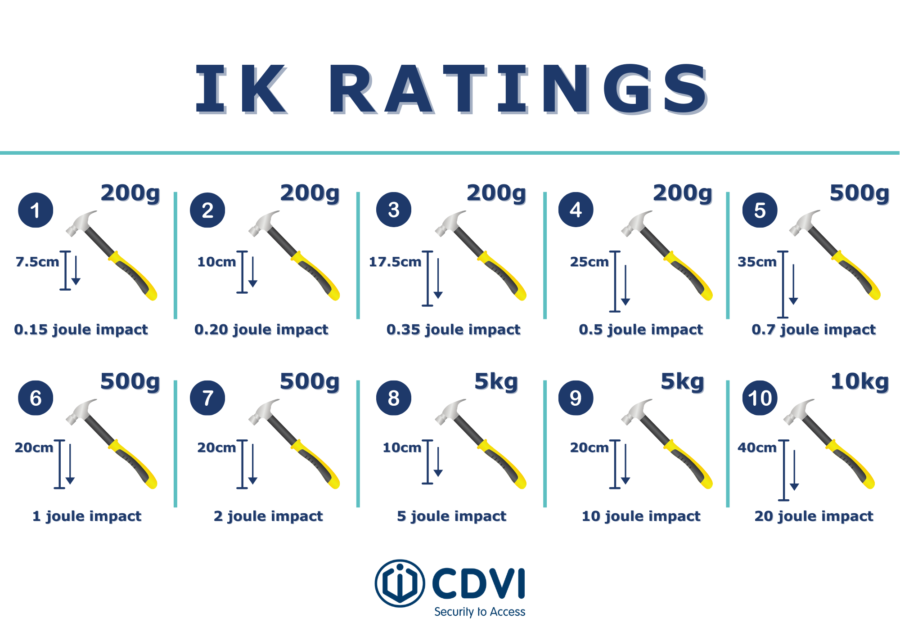K1BT
KRYPTO Mobile Ready Reader
IP and IK protection ratings are a common specification in access control products. These are indicators of how ‘protected’ the item is from various factors. Most often, you will see these technicalities presented as “weather resistant” or “vandal resistant.” But what do these acronyms and the numbers next to them mean?
Scroll to learn more
The IP or “Ingress Protection” ratings are an industry-recognized system, created by the International Electrotechnical Commission (IEC 60529). Used to determine the different degrees of protection of the enclosures of electrical and electronic equipment against external elements. In this case, the degree of protection IP indicates the level of resistance to solid agents (dirt/dust) and moisture (drips, sprays, submersion etc.).
The degree of protection IP always consists of two numbers. The first digit refers to the level of protection against solids, while the second digit indicates the level of resistance to water. The first digit runs on a scale from 0-6, while the second goes up to 8. Therefore, the lowest possible degree of protection is IP00 and the highest is IP68.
For example, the ievo ultimate™ biometric fingerprint reader (pictured) is rated IP65. That’s a pretty high rating – the highest possible protection against dust getting into the product and a solid level of protection against jetted water. A rating like this means the ultimate™ can be safely installed outdoors.
In the following table, find a summary of each rating definition.
| LEVEL |
First digit(Entrance of solid agents) |
Second digit(Entrance of water) |
0 |
No protection. | No protection. |
1 |
Protected against solids objects over 50mm (e.g. accidental touch by hands | No water should enter when it falls from 200mm in height from the equipment, for 10 minutes (at a rate of 3-5mm³ per minute) |
2 |
Protected against solids objects over 12mm (e.g. fingers) | Protected against direct sprays up to 15o from the vertical. |
3 |
Protected against solids objects over 2.5mm (e.g. tools and wires). | Protected against direct sprays up to 60o from the vertical, at an average of 11 litres per minute and at a pressure of 800-100 kN / m² for a time not less than 5 minutes. |
4 |
Protected against solids objects over 1mm (e.g. tools, wires and small wires. | Protected against sprays from all directions, at an average of 10 litres per minute and at a pressure of 800-100 kN / m² for a time not less than 5 minutes – limited ingress permitted. |
5 |
Protected against dust – limited ingress (no harmful deposit) | Jetted water (from any angle) must not enter by means of a 6.3 mm diameter nozzle, at an average of 12.5 litres per minute and at a pressure of 30 kN / m² for a time not less than 3 minutes and at a distance not less than 3 meters – limited ingress permitted. |
6 |
Completely protected against the entrance of dust. | Jetted water (from any angle) must not enter by means of a nozzle of 12.5 mm in diameter, an average of 100 litres per minute and a pressure 100 kN / m² for a time not less than 3 minutes and at a distance that is not less than 3 meters e.g. for use on ship decks – limited ingress permitted. |
7 |
N/A | The equipment must withstand without any filtration the complete immersion between 15cm and 1m for 30 minutes. |
8 |
N/A | Protected against long periods of immersion under pressure. |
IK stands for “Impact Protection” (the K is from “Kinetic” to differentiate from IP rating). It is defined in international standards and indicates protection against mechanical impact. Just like IP protection, this code is governed by an international standard (IEC 62262), so that you can make comparisons between different products. In this case, the mechanical resistance to harmful impacts that could damage a product.
The IK grade varies from 0 (minimum resistance) to 10 (maximum resistance). For example, our NANO, STAR, and SOLAR (pictured) readers are all IK10 rated – the highest possible rating.
In the following table, you can see in more detail the different IK degree values and the energy of impact that the product can withstand.
Not all impacts come from criminal intentions. Flying debris, such as ones from storms, can also present problems for specific products. This is where both the IP and IK numbers come into play, as you want a product that will survive surging water, but also anything picked up by the wind.